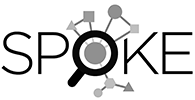SPOKE
Scalable Precision Medicine Open Knowledge Environment is a very large network containing multiple types of biological data. Pooling such diverse data into a single knowledge environment allows identifying new connections, with implications for biomedical applications like personalized medicine: suggesting which drugs may be effective for a specific patient. An earlier version of the network was used to suggest new uses for existing drugs.
SPOKE is a heterogeneous network, meaning that different nodes (points) within the network can represent different types of data. The edges between pairs of nodes represent known connections. Paths that follow a series of edges may connect nodes not previously known to be related.
Neighborhood Explorer
Neighborhood Explorer allows searching SPOKE for a node of interest, such as a specific drug compound, gene, or protein, and seeing what other nodes are in its immediate connectivity neighborhood, such as related diseases, side effects, pathways, and other compounds, genes, or proteins. The search can be limited by filtering to specific node and edge types, and by edge value (for example, compound-treats-disease edges at least clinical trial phase 3 or FDA-approved). The resulting network is displayed with color-coding by node type. Detailed information is shown for a specific node or edge on mouseover. Results can be extended further from any node of interest, subject to the current filter settings, by clicking a node to select it and then clicking the Extend button.
When a given node has many radiating “leaf” nodes attached to it, for easier viewing of the rest of the network, these leaves can be collapsed onto their central node, and later re-expanded if the user wishes.
Visit SPOKE's Neighborhood Explorer
